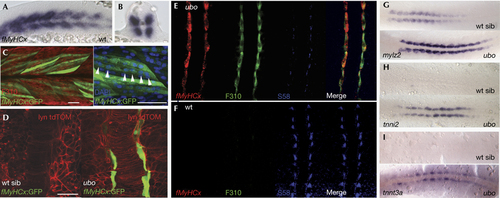
Fast-muscle-fibre-specific genes are ectopically expressed in the slow domain of ubotp39 mutant embryos. In situ hybridization showing fast-muscle-specific expression of the fast myosin heavy chain gene (fMyHCx) at the 18-somite stage in (A) lateral and (B) transverse views. (C) An fMyHCx:GFP construct expresses GFP specifically in the fast-muscle fibres in the trunk. Transient expression of fMyHCx:GFP in the fast fibres in a 30 hpf (hours post fertilization) embryo, as shown by the colocalization with the fast-fibre marker F310 antigen. Nuclei were stained with 4,6-diamidino-2-phenylindole (DAPI) to highlight the polynuclear arrangement (arrowheads) of the fast fibres expressing fMyHCx:GFP. (D) The construct fMyHCx:GFP is detected in the adaxial cells of ubotp39 mutants in transient assays. The fMyHCx:GFP construct is not expressed at the 12-somite stage in wild-type embryos, but is ectopically expressed in the adaxial cells of a 12-somite-stage ubotp39 embryo. Lyn tdTomato (red) was used to highlight cellular membranes and the outline of the notochord. (E,F) Ectopic expression of fMyHCx messenger RNA (red) and F310 (green) is detected in the adaxial cells of a 12-somite-stage ubotp39 embryo (100% of embryos assayed; n>30). In wild-type siblings (wt sib), adaxial cells are only labelled with the slow MyHC S58 (blue) antibody. Genes that normally are expressed exclusively in the fast-muscle domain are ectopically expressed in the adaxial cells of the ubotp39 mutant: (G) mylz2, (H) tnni2 and (I) tnnt3a. Scale bars, 25 μm. GFP, green fluorescent protein; mylz2, myosin light chain 2; tnni2, troponin I2; tnnt3a, troponin T3a; ubo, u-boot; wt, wild type.
|

